
Schinia, commonly called flower moths, is a large genus of moths belonging to the family Noctuidae. The genus has a Holarctic distribution with the vast majority of species being found in North America, many with a very restricted range and larval food plant.

Tegeticula yuccasella, the yucca moth, is a moth of the family Prodoxidae. The species was first described by Charles Valentine Riley in 1872. It can be found in North America from Texas to southern Canada.

Perispasta is a genus of moths of the family Crambidae. It contains only one species, Perispasta caeculalis, or Titian Peale's pyralid moth, which is found in North America, where it has been recorded from Quebec west to British Columbia, south to Florida, Texas and Colorado. The habitat consists of fields and meadows. Both the genus and species were first described by Philipp Christoph Zeller in 1875.
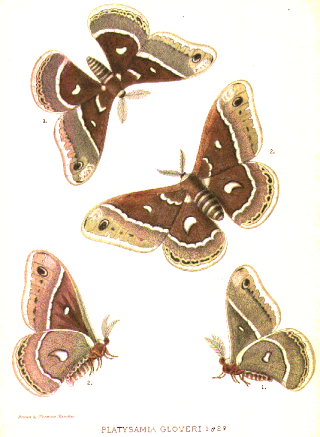
Hyalophora gloveri, or Glover's silkmoth, is a moth of the family Saturniidae. The species was first described by Ferdinand Heinrich Hermann Strecker in 1872. It is found in the Rocky Mountain states, the western parts of the northern Great Plains, and the Canadian prairie provinces, north-west to at least central Alberta. It is also found in northern Mexico.
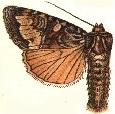
Apamea occidens, the western apamea, is a moth of the family Noctuidae. The species was first described by Augustus Radcliffe Grote in 1878. It is native to western North America as far east as Alberta and Kansas.

Mompha idaei is a moth in the family Momphidae first described by Philipp Christoph Zeller in 1839. It has a Holarctic distribution; in North America it is found from coast to coast in the boreal forest south to Colorado and Washington.

Eulogia is a monotypic snout moth genus described by Carl Heinrich in 1956. Its only species is Eulogia ochrifrontella, the broad-banded eulogia moth, described by Philipp Christoph Zeller in 1875. It is found in most of North America, including British Columbia, Florida, Illinois, Maine, Manitoba, Massachusetts, Minnesota, New Jersey, Oklahoma, Ontario, Pennsylvania, Tennessee, Virginia and Washington.

Macaria aemulataria, the common angle moth, is a moth in the family Geometridae. The species was first described by Francis Walker in 1861. It is found from Nova Scotia to Florida, west to Texas, north to Oregon and Alberta.

Chrysoteuchia topiarius, the topiary grass-veneer moth, subterranean sod webworm or cranberry girdler, is a moth of the family Crambidae. The species was first described by Philipp Christoph Zeller in 1866. It is found in most of North America.

Dioryctria auranticella, the ponderosa pineconeworm moth, is a moth of the family Pyralidae. The species was first described by Augustus Radcliffe Grote in 1883. It is found in western North America from southern British Columbia south to California and Arizona, east to South Dakota and New Mexico.

Dioryctria ponderosae, the ponderosa twig moth, is a moth of the family Pyralidae. The species was first described by Harrison Gray Dyar Jr. in 1914. It is found in North America from Washington and Montana south to California and northern Mexico.
Bandera is a genus of snout moths. It was described by Émile Louis Ragonot in 1887 and is known from the United States.
Bandera virginella is a species of snout moth in the genus Bandera. It was described by Harrison Gray Dyar Jr. in 1908, and is found in the US from southern Alberta and Washington, south through Colorado to California and New Mexico.
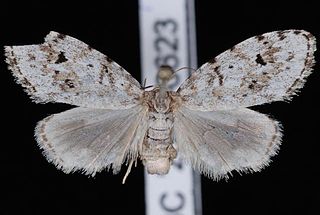
Clemensia albata, the little white lichen moth, is a moth of the family Erebidae. It was described by Alpheus Spring Packard in 1864. It is found in eastern North America, west across boreal Canada to south-eastern British Columbia. The range extends along the Pacific Coast south to Monterey Bay in west-central California. The habitat consists of moist forests, including coastal rainforests, oak woodlands and mixed hardwood forests.

Agriphila ruricolella, the lesser vagabond sod webworm, is a moth in the family Crambidae. It was described by Philipp Christoph Zeller in 1863. It is found in North America, where it has been recorded from Quebec and Maine to South Carolina, west to Arizona and north to Alberta. The habitat consists of grasslands, weedy areas, fields and cultivated areas.

Crambus bidens, the forked grass-veneer, is a moth in the family Crambidae. It was described by Philipp Christoph Zeller in 1872. It is found in North America, where it has been recorded from Massachusetts, New York, Ontario, New Jersey, Quebec, Michigan and Alberta. The habitat consists of bogs.
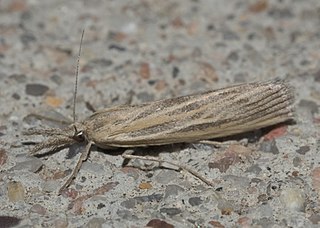
Thaumatopsis pexellus, the woolly grass-veneer, is a moth in the family Crambidae. It was described by Philipp Christoph Zeller in 1863. It is found in most of North America. The habitat consists of grasslands.

Loxostege lepidalis is a moth in the family Crambidae. It was described by George Duryea Hulst in 1886. It is found in North America, where it has been recorded from Alberta and eastern Washington to California and New Mexico.
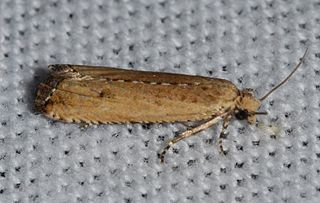
Bactra verutana, the javelin moth, is a species of moth of the family Tortricidae. It is found in North America, where it has been recorded from Florida, Texas, Mississippi, North Carolina, Indiana, Missouri, Ontario, Alberta, Quebec and Labrador. It is also found in Cuba, Mexico, Panama, Paraguay, Puerto Rico, Mozambique and South Africa. The habitat consists of prairies, aspen parkland, foothills and mixed wood areas.
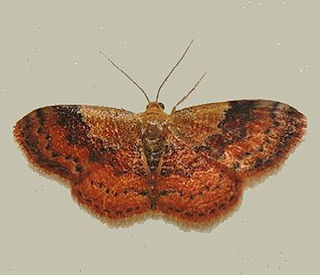
Leptostales ferruminaria, the light-ribboned wave, is a moth of the family Geometridae. The species was first described by Philipp Christoph Zeller in 1872. It is found in North America, where it has been recorded from eastern North America west to Oklahoma and north to British Columbia. The habitat consists of dry shrubby areas and wooded edges along the floodplains of prairie rivers.
















